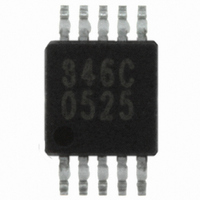CS4346-CZZ Cirrus Logic Inc, CS4346-CZZ Datasheet - Page 15

CS4346-CZZ
Manufacturer Part Number
CS4346-CZZ
Description
IC DAC 24BIT 192KHZ 10-TSSOP
Manufacturer
Cirrus Logic Inc
Datasheet
1.CS4344-CZZ.pdf
(24 pages)
Specifications of CS4346-CZZ
Data Interface
Serial
Number Of Bits
24
Number Of Converters
2
Voltage Supply Source
Single Supply
Power Dissipation (max)
150mW
Operating Temperature
-10°C ~ 70°C
Mounting Type
Surface Mount
Package / Case
10-TSSOP
Resolution (bits)
24bit
Sampling Rate
192kSPS
Input Channel Type
Serial
Supply Current
22mA
Digital Ic Case Style
TSSOP
No. Of Pins
10
Lead Free Status / RoHS Status
Lead free / RoHS Compliant
Settling Time
-
Lead Free Status / RoHS Status
Lead free / RoHS Compliant, Lead free / RoHS Compliant
Other names
598-1053-5
Available stocks
Company
Part Number
Manufacturer
Quantity
Price
DS613F1
4.3
4.4
The Initialization and Power-down sequence flow chart is shown in
Power-Down State upon initial power-up. The interpolation filters and delta-sigma modulators are reset, and the
internal voltage reference, multi-bit digital-to-analog converters and switched-capacitor low-pass filters are pow-
ered down. The device will remain in the Power-down mode until MCLK and LRCK are present. Once MCLK and
LRCK are detected, MCLK occurrences are counted over one LRCK period to determine the MCLK/LRCK fre-
quency ratio. Power is then applied to the internal voltage reference. Finally, power is applied to the D/A converters
and switched-capacitor filters, and the analog outputs will ramp to the quiescent voltage, VQ.
4.5
4.5.1
4.5.2
.
De-Emphasis
The CS4344 family includes on-chip digital de-emphasis.
equal to 44.1 kHz. The frequency response of the de-emphasis curve will scale proportionally with changes
in sample rate, Fs.
The de-emphasis filter is active (inactive) if the DEM/SCLK pin is low (high) for 5 consecutive falling edges
of LRCK. This function is available only in the internal serial clock mode
Initialization and Power-Down
Output Transient Control
The CS4344 family uses Popguard
up and power-down. This technique eliminates the audio transients commonly produced by single-ended
single-supply converters when it is implemented with external DC-blocking capacitors connected in series
with the audio outputs. To make best use of this feature, it is necessary to understand its operation.
Power-Up
When the device is initially powered-up, the audio outputs, AOUTL and AOUTR, are clamped to VQ which
is initially low. After MCLK is applied the outputs begin to ramp with VQ towards the nominal quiescent
voltage. This ramp takes approximately 250 ms with a 3.3 µF cap connected to VQ (420 ms with a 10 µF
connected to VQ) to complete. The gradual voltage ramping allows time for the external DC-blocking ca-
pacitors to charge to VQ, effectively blocking the quiescent DC voltage. Once valid LRCK and SDIN are
supplied (and SCLK if used) approximately 2000 sample periods later audio output begins.
Power-Down
To prevent audio transients at power-down the DC-blocking capacitors must fully discharge before turning
off the power. In order to do this MCLK should be stopped for a period of about 250 ms for a 3.3 µF cap
connected to VQ (420 ms for a 10 µF cap connected to VQ) before removing power. During this time volt-
age on VQ and the audio outputs discharge gradually to GND. If power is removed before this time period
has passed a transient will occur when the VA supply drops below that of VQ. There is no minimum time
for a power cycle, power may be re-applied at any time.
Figure 11. De-Emphasis Curve (Fs = 44.1kHz)
-10dB
Gain
0dB
dB
™
technology to minimize the effects of output transients during power-
3.183 kHz
T1=50 µs
F1
10.61 kHz
F2
T2 = 15 µs
Figure 11
Frequency
Figure
12. The CS4344 family enters the
shows the de-emphasis curve for Fs
CS4344/5/6/8
15




















